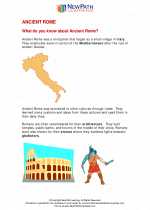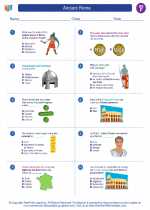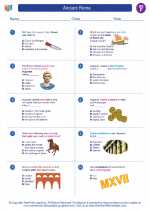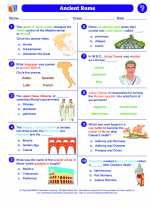Ancient Rome
Ancient Rome was a powerful and influential civilization that emerged in the 8th century BCE and grew to become one of the largest empires in the ancient world. It was located in the Italian Peninsula and eventually expanded to encompass the Mediterranean region, parts of Asia, and parts of Europe. The civilization had a profound impact on language, law, engineering, architecture, and government systems, and its legacy continues to influence modern society.
Key Aspects of Ancient Rome
- Government and Politics: Rome started as a monarchy and later became a republic, with a complex system of checks and balances. The republic evolved into an empire, with emperors wielding significant power.
- Social Structure: Roman society was divided into different classes, including patricians (wealthy landowners), plebeians (common people), and slaves. The concept of citizenship was also significant.
- Engineering and Architecture: Romans were known for their advanced engineering feats, including the construction of roads, aqueducts, and monumental structures like the Colosseum and the Pantheon.
- Religion and Mythology: The Romans had a pantheon of gods and goddesses, and their religious practices influenced various aspects of daily life, public ceremonies, and governance.
- Expansion and Conquest: Rome expanded through military conquest, eventually controlling vast territories and diverse populations across Europe, North Africa, and the Middle East.
Study Guide
Here are some key points to focus on while studying Ancient Rome:
- What were the major achievements of Ancient Rome in terms of governance, engineering, and architecture?
- How did the social structure of Ancient Rome contribute to its political dynamics and conflicts?
- What were the key factors that contributed to the rise and fall of the Roman Empire?
- Examine the influence of Roman mythology and religious practices on daily life and governance.
- Investigate the impact of Roman expansion on the territories they conquered and the diverse cultures they encountered.
By exploring these topics, you can gain a comprehensive understanding of the significance and impact of Ancient Rome on world history.
[Ancient Rome] Related Worksheets and Study Guides:
.◂Social Studies Worksheets and Study Guides Sixth Grade. Ancient Rome
Study Guide Ancient Rome
Ancient Rome  Worksheet/Answer key
Worksheet/Answer key Ancient Rome
Ancient Rome  Worksheet/Answer key
Worksheet/Answer key Ancient Rome
Ancient Rome  Worksheet/Answer key
Worksheet/Answer key Ancient Rome
Ancient Rome  Worksheet/Answer key
Worksheet/Answer key Ancient Rome
Ancient Rome 

 Worksheet/Answer key
Worksheet/Answer key
 Worksheet/Answer key
Worksheet/Answer key
 Worksheet/Answer key
Worksheet/Answer key
 Worksheet/Answer key
Worksheet/Answer key

Create And Print Roman Numerals worksheets with Roman Numerals Worksheets generator
The resources above cover the following skills:
National Curriculum Standards for Social Studies (NCSS)
TIME, CONTINUITY, AND CHANGE
SOCIAL STUDIES PROGRAMS SHOULD INCLUDE EXPERIENCES THAT PROVIDE FOR THE STUDY OF THE PAST AND ITS LEGACY.
KNOWLEDGE - Learners will understand:
The study of the past provides a representation of the history of communities, nations, and the world.
That learning about the past requires the interpretation of sources, and that using varied sources provides the potential for a more balanced interpretive record of the past.
That historical interpretations of the same event may differ on the basis of such factors as conflicting evidence from varied sources, national or cultural perspectives, and the point of view of the researcher.
Key historical periods and patterns of change within and across cultures (e.g., the rise and fall of ancient civilizations, the development of technology, the rise of modern nation-states, and the establishment and breakdown of colonial systems).
The contributions of key persons, groups, and events from the past and their influence on the present.
The influences of social, geographic, economic, and cultural factors an the history of local areas, states, nations, and the world.
PEOPLE, PLACES, AND ENVIRONMENTS
SOCIAL STUDIES PROGRAMS SHOULD INCLUDE EXPERIENCES THAT PROVIDE FOR THE STUDY OF PEOPLE, PLACES, AND ENVIRONMENTS.
PRODUCTS - Learners demonstrate understanding by:
Constructing a map depicting the historical expansion of a nation or empire that demonstrates an understanding of relative location, distance, direction, boundaries, major physical features, size, and shape.
National Center for History in Schools (NCHS)
Historical Thinking Standards
Chronological Thinking
Identify the temporal structure of a historical narrative or story.
Reconstruct patterns of historical succession and duration; explain historical continuity and change.
Historical Comprehension
Reconstruct the literal meaning of a historical passage.
Identify the central question(s) the historical narrative addresses.
Historical Analysis and Interpretation
Draw comparisons across eras and regions in order to define enduring issues.
Challenge arguments of historical inevitability.
Hold interpretations of history as tentative.
Historical Research Capabilities
Formulate historical questions.
Historical Issues-Analysis and Decision-Making
Identify issues and problems in the past.
Identify relevant historical antecedents.
World History Content Standards
Era 3: Classical Traditions, Major Religions, and Giant Empires, 1000 BCE-300 CE
How major religions and large-scale empires arose in the Mediterranean basin, China, and India, 500 BCE-300 CE.
The student understands the causes and consequences of the unification of the Mediterranean basin under Roman rule.
The student understands the emergence of Christianity in the context of the Roman Empire.
Major global trends from 1000 BCE-300 CE.
The student understands major global trends from 1000 BCE to 300 CE.
Era 4: Expanding Zones of Exchange and Encounter, 300-1000 CE
Imperial crises and their aftermath, 300-700 CE.
The student understands the decline of the Roman and Han empires.